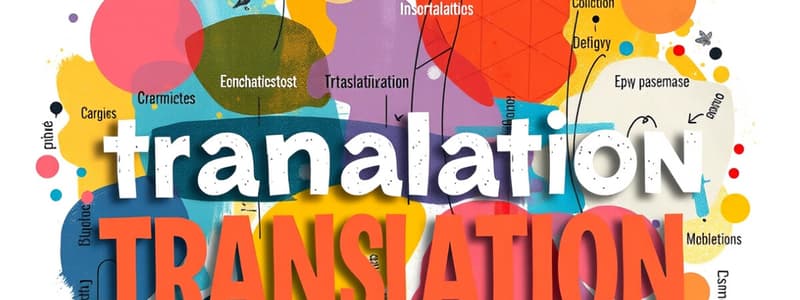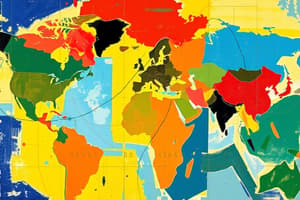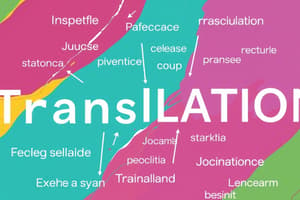Podcast
Questions and Answers
What is oral translation primarily focused on?
What is oral translation primarily focused on?
- Translating written texts only
- Rendering spoken messages, written messages, or sign language gestures (correct)
- Translating only technical documents
- Using special software for translation
Which translation method is typically more accurate?
Which translation method is typically more accurate?
- Sight Translation
- Machine Translation
- Human Translation (correct)
- Sign Language Translation
Which type of translation would involve translating legal documents?
Which type of translation would involve translating legal documents?
- Literary translation
- Media translation
- Legal translation (correct)
- Technical translation
What distinguishes written translation from oral translation?
What distinguishes written translation from oral translation?
In terms of translation types, which of the following is NOT a distinct category mentioned?
In terms of translation types, which of the following is NOT a distinct category mentioned?
What does the term 'TT' stand for in Translation Studies?
What does the term 'TT' stand for in Translation Studies?
Which type of translation focuses on the medium through which information is conveyed?
Which type of translation focuses on the medium through which information is conveyed?
What is a primary concern in translation quality assessment?
What is a primary concern in translation quality assessment?
Which of the following best describes 'equivalence' in translation?
Which of the following best describes 'equivalence' in translation?
Which term refers to the text being translated?
Which term refers to the text being translated?
What is one essential skill for interpreters?
What is one essential skill for interpreters?
Which of the following is NOT a type of interpreting?
Which of the following is NOT a type of interpreting?
What aspect influences the definition of translation according to different scholars?
What aspect influences the definition of translation according to different scholars?
What is the main focus of translation as described in the content?
What is the main focus of translation as described in the content?
According to House's definition, what is a criterion for an adequate translation?
According to House's definition, what is a criterion for an adequate translation?
What are the abbreviations ST and SL used for in translation studies?
What are the abbreviations ST and SL used for in translation studies?
What term refers to the final product of a translation?
What term refers to the final product of a translation?
Which of the following definitions emphasizes the author's intention in translation?
Which of the following definitions emphasizes the author's intention in translation?
How is 'text' defined according to Stubbs?
How is 'text' defined according to Stubbs?
What is a common challenge faced by translators according to the content?
What is a common challenge faced by translators according to the content?
Which of the following statements reflects a misconception about translation?
Which of the following statements reflects a misconception about translation?
What is context defined as?
What is context defined as?
What defines a message in the context of a text?
What defines a message in the context of a text?
What is a translation problem?
What is a translation problem?
What does translation technique refer to?
What does translation technique refer to?
What is translation equivalence?
What is translation equivalence?
What does translation loss signify?
What does translation loss signify?
Which of the following best describes the author in the context of a text?
Which of the following best describes the author in the context of a text?
What is meant by 'borrowing' in translation methods?
What is meant by 'borrowing' in translation methods?
What distinguishes human translation from machine translation?
What distinguishes human translation from machine translation?
Which type of translation specifically deals with the rendering of technical documents?
Which type of translation specifically deals with the rendering of technical documents?
Which category of translation is NOT mentioned as a type according to field?
Which category of translation is NOT mentioned as a type according to field?
Which of the following best describes sight translation?
Which of the following best describes sight translation?
What is a characteristic of machine translation compared to human translation?
What is a characteristic of machine translation compared to human translation?
What is the primary objective of translation?
What is the primary objective of translation?
Which factor can influence the definition of translation?
Which factor can influence the definition of translation?
Which of the following best describes the 'translation problem'?
Which of the following best describes the 'translation problem'?
What are the basic terms used in Translation Studies, such as ST and TT, primarily focused on?
What are the basic terms used in Translation Studies, such as ST and TT, primarily focused on?
Which skill is particularly important for translators in the context of translation?
Which skill is particularly important for translators in the context of translation?
Why is equivalence significant in translation?
Why is equivalence significant in translation?
What element is NOT typically considered when assessing translation quality?
What element is NOT typically considered when assessing translation quality?
What distinguishes interpreting from translation?
What distinguishes interpreting from translation?
What does translation loss primarily refer to?
What does translation loss primarily refer to?
Which factor can contribute to translation problems?
Which factor can contribute to translation problems?
What is the goal of a translation technique?
What is the goal of a translation technique?
How is translation equivalence best defined?
How is translation equivalence best defined?
What role does the audience play in the communication process of a text?
What role does the audience play in the communication process of a text?
What type of translation method involves the use of borrowed terms?
What type of translation method involves the use of borrowed terms?
What does the term 'author' signify in the context of a text?
What does the term 'author' signify in the context of a text?
What does the concept of 'context' help facilitate in understanding a text?
What does the concept of 'context' help facilitate in understanding a text?
What is the main intent of translation according to Newmark's definition?
What is the main intent of translation according to Newmark's definition?
Which of the following best defines the term 'equivalence' in translation studies?
Which of the following best defines the term 'equivalence' in translation studies?
What does 'TT' stand for in the context of translation studies?
What does 'TT' stand for in the context of translation studies?
In translation studies, what role does 'context' play according to Stubbs?
In translation studies, what role does 'context' play according to Stubbs?
Which definition reflects a common understanding of 'translation loss'?
Which definition reflects a common understanding of 'translation loss'?
What is the primary focus of translation as stated by Nida and Taber?
What is the primary focus of translation as stated by Nida and Taber?
According to Nord's definition, what does a functional target text imply?
According to Nord's definition, what does a functional target text imply?
Which statement about the abstract view of translation is accurate based on the provided content?
Which statement about the abstract view of translation is accurate based on the provided content?
Flashcards are hidden until you start studying
Study Notes
Introduction to Translation
- Translation encompasses various definitions and interpretations, influenced by different schools of thought.
- Notable definitions include:
- Catford: An operation substituting a text in one language for a text in another.
- Nida & Taber: Reproduction in the receptor language of the closest natural equivalent in meaning and style.
- Newmark: Rendering meaning into another language as intended by the author.
- Nord: Functional reproduction of a target text maintaining a relationship with the source text.
Basic Terms in Translation Studies
- ST: Source Text; the original text.
- SL: Source Language; language of the ST.
- TT: Target Text; the translated product.
- TL: Target Language; language of the TT.
- Text: Instance of language use, must convey a meaningful message.
- Context: The circumstances that provide understanding for an event, statement, or idea.
Key Concepts
- Message: Idea or purpose conveyed by a text, understood within its context.
- Author: Originator of the text; creator of the message.
- Audience: Receiver of the text/message.
- Translation Problem: Challenges faced by translators in translating various elements—lexical, grammatical, cultural, etc.
Translation Techniques and Equivalence
- Translation Technique: Methods a translator employs to render meanings from ST units; includes:
- Free translation
- Literal translation
- Borrowing
- Functional translation
- Translation Equivalence: Degree of similarity in meaning and effect between the ST and TT.
- Translation Loss: Information or elements lost during translation due to differences in structure or culture.
Types of Translation
- According to Medium:
- Oral Translation: Spoken messages translated through interpreting.
- Written Translation: Translating written texts such as documents, books, articles.
- According to Agent:
- Human Translation: Performed by a human translator.
- Machine Translation: Executed by software, often less accurate compared to human translations.
- According to Field: Various specialized translations catering to different subject areas, including:
- Literary translation
- Technical translation
- Scientific translation
- Legal translation
- Media translation
- Business translation
- Political translation
- Medical translation
Importance of Translation
- Translation facilitates understanding across different languages and cultures, serving various fields and audiences.
- It plays a critical role in knowledge transfer, media communication, and the dissemination of information globally.
Introduction to Translation
- Translation encompasses various definitions and interpretations, influenced by different schools of thought.
- Notable definitions include:
- Catford: An operation substituting a text in one language for a text in another.
- Nida & Taber: Reproduction in the receptor language of the closest natural equivalent in meaning and style.
- Newmark: Rendering meaning into another language as intended by the author.
- Nord: Functional reproduction of a target text maintaining a relationship with the source text.
Basic Terms in Translation Studies
- ST: Source Text; the original text.
- SL: Source Language; language of the ST.
- TT: Target Text; the translated product.
- TL: Target Language; language of the TT.
- Text: Instance of language use, must convey a meaningful message.
- Context: The circumstances that provide understanding for an event, statement, or idea.
Key Concepts
- Message: Idea or purpose conveyed by a text, understood within its context.
- Author: Originator of the text; creator of the message.
- Audience: Receiver of the text/message.
- Translation Problem: Challenges faced by translators in translating various elements—lexical, grammatical, cultural, etc.
Translation Techniques and Equivalence
- Translation Technique: Methods a translator employs to render meanings from ST units; includes:
- Free translation
- Literal translation
- Borrowing
- Functional translation
- Translation Equivalence: Degree of similarity in meaning and effect between the ST and TT.
- Translation Loss: Information or elements lost during translation due to differences in structure or culture.
Types of Translation
- According to Medium:
- Oral Translation: Spoken messages translated through interpreting.
- Written Translation: Translating written texts such as documents, books, articles.
- According to Agent:
- Human Translation: Performed by a human translator.
- Machine Translation: Executed by software, often less accurate compared to human translations.
- According to Field: Various specialized translations catering to different subject areas, including:
- Literary translation
- Technical translation
- Scientific translation
- Legal translation
- Media translation
- Business translation
- Political translation
- Medical translation
Importance of Translation
- Translation facilitates understanding across different languages and cultures, serving various fields and audiences.
- It plays a critical role in knowledge transfer, media communication, and the dissemination of information globally.
Studying That Suits You
Use AI to generate personalized quizzes and flashcards to suit your learning preferences.




